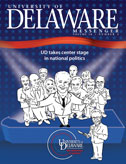Tiny bubbles hold big potential for health care

RESEARCH | Key objectives of modern health care are early and accurate diagnosis of a disease and quick remediation with minimal side effects.
So imagine a tiny bubble, or liposome, that can be inserted into the human body and delivered to a specific target to provide both precise diagnosis of a cancerous tumor and intelligent drug delivery to combat that tumor.
The dual-purpose liposome is at the heart of joint research being conducted by teams from the University of Delaware and North Dakota State University in a collaborative project funded by a three-year, $586,715 grant from the National Science Foundation to be shared equally between the two universities.
“This proposal addresses all of the important elements of health care, with concurrent imaging and targeted and controlled drug release,” says Kausik Sarkar, associate professor of mechanical engineering at UD.
He is conducting the research in cooperation with Sanku Mallik, professor of pharmaceutical sciences at North Dakota State. Sarkar says the goal of the project is to develop lipid bilayer encapsulated liposomes, a field in which Mallik is a noted expert.
“The liposomes are excellent agents for medical purposes because of their close structural resemblance with animal cells, and can be loaded with drugs and genes to be delivered to target tissues,” Sarkar says.
They also can be designed to be diagnostic for better use in ultrasound imaging, which is Sarkar’s field of expertise. Ultrasound, which uses a pulsing high-frequency sound beyond the upper limit of human hearing to peer into the body and provide images, is an important tool in modern health care.
Mallik will devise liposomes that are echogenic, containing gases that would reflect ultrasound and show up in ultrasound images. He also will make the encapsulation of the liposomes with specially designed molecules that would attach to target enzymes expressed in plaques or cancerous tumors, Sarkar says.
That would enable accurate ultrasound diagnosis of the disease while, at the same time, reaction with the enzymes would uncork the liposomes and release the contained drug to only the target tissue.





